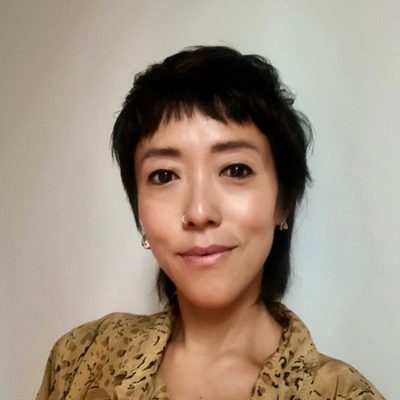Weaving a Feminist Movement
Women in Bengaluru are unraveling patriarchy, stitch by stitch, song by song.
Panthea Lee (李佩珊)

Artist Indu Antony was enjoying conversation over chai at a women’s center in Bengaluru, India, when an angry man walked in. He tore a piece of art off the wall, took a lighter from his pocket, and set it on fire. Antony’s companions recognized the man as a local official in a right-wing political party; they scampered away.
“This is a center that is attacking men,” the official fumed. It was three in the afternoon, and Antony smelled a day’s worth of drink on his breath. “You cannot burn our stories,” Antony shot back. The man’s eyes flared; he was not used to being challenged.
The two went back and forth, debating the community center she had founded: Is something created for women inherently against men? In a city with so few safe spaces for women, why did he think it was okay to charge in? Just as the official’s voice grew louder, his tone more belligerent, Antony sensed movement behind her.
“Don’t talk to her like that!” All of her sisters had returned, and now formed a wall behind her. The official was catatonic. The women were all likely lower-caste; those who worked did so as domestic workers and street cleaners. Women — especially poor women— were not supposed to talk back.
After he stormed off, the women huddled over the singed fabric. It was part of an artpiece they were creating, stitching fragments of their lives onto shreds of cloth and into a room-sized tapestry of stories.
The words on this piece read: “It hurts a lot when he beats me.” They recognized the stitching — it belonged to one of their sisters. She had recently been hospitalized after what neighbors shrugged off as a lover’s quarrel. The official had come to destroy the evidence.
THE MOST DANGEROUS COUNTRY FOR WOMEN
In 2018, a poll of international experts on women’s issues declared India the world’s most dangerous country for women, citing the high risks of sexual violence and being forced into slave labor. That year, women reported a rape in India every 15 minutes.
The poll generated intense national debate: Surely we weren’t the most dangerous — worse than war-torn Afghanistan and Syria, which ranked second and third, respectively? But the results confirmed what many women had long suspected, even if they never articulated it.
Politicians insisted that great strides were being made, but too many women were familiar with the routines to gaslight and mollify. Following high-profile crimes against women, elected officials would inevitably wring their hands and promise change. Take the case of “Nirbhaya,” a 23-year-old student in Delhi who, in 2012, was beaten, gang-raped and tortured on a bus, by the driver and five passengers. When she arrived at the hospital, doctors found only 5% of her intestines left in her body; she died two weeks later.
The tragedy sparked nationwide protests and led to stronger rape laws; a victim’s character could no longer be considered in a case, and the length of minimum sentences increased. But more than a decade later, advocates say little has actually improved. From 2011 to 2021, the rate of crimes against women in India increased 87%.
While the safety of women has continued to decline, their importance — and thus their instrumentalization — in Indian politics has grown. Women are now a crucial voting bloc, and political parties have been courting them with promises of income assistance, subsidized gas and electricity, and all-women police stations.
Women are also vital to India fulfilling its promise as an economic powerhouse. While women currently perform 91% of daily unpaid care work, their participation in the formal workforce is only 24%. According to McKinsey, women’s underrepresentation in India’s formal economy translates to $2.9 trillion in annual lost opportunity. Eager to seize this potential, the government has rolled out skills development programs, entrepreneurship support and new maternity leave policies.
But what does it mean to be a woman in a world that commits unspeakable violence against you, then demands you serve its economic ambitions? How to exist in a world that ignores your suffering, yet insists you support its “progress”?
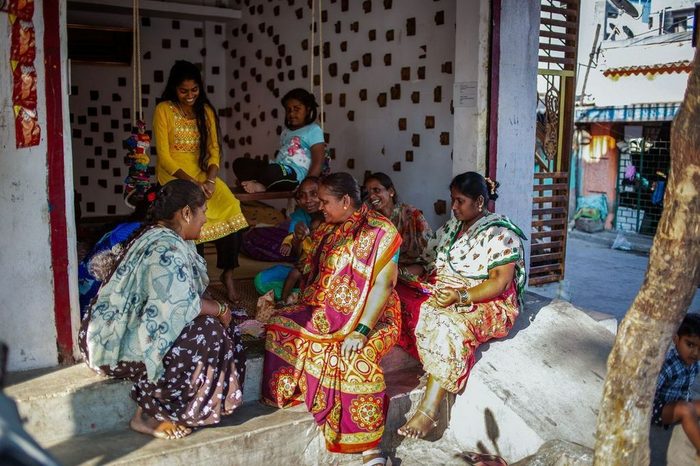
A ROOM OF OUR OWN
The pain and precarity of being a woman once filled Indu Antony with rage. In her youth, she was a regular at demonstrations: “if someone was protesting something, I was there.” But she soon saw the limits of protest: Rallies were largely led by upper-class people who had the time to organize and the confidence to demand change, but who lacked the ability to imagine radical alternatives — perhaps because, for them, there was less at stake.
Antony was eager for true grassroots change she could touch. To realize such change, she suspected, women needed to come together regularly, not just in crisis. They needed to rally around shared dreams, not just commiserate over shared heartaches.
They needed a space of their own.
In 2022, Namma Katte (“Our Space” in Kannada) was born. It is a rectangular, 25-square-foot room in Lingarajapuram, a working-class neighborhood in Bengaluru, where women are typically at home by 6p.m.; it was risky to be out later.
Months before Namma Katte’s opening, locals had found a mysterious bag on a nearby street; inside was a woman’s body parts, chopped up and caked with blood. Locals told Antony this was not the first such discovery.
In announcing Namma Katte on Instagram, Antony wrote: “This space is to bring back the sense of community and laugh together. A space to gossip and start change with conversations. A space where we will dance with no control and where we will sell idlis. … A space to wait and think. A space to read and scream. A space that will eventually be taken over by the people themselves. To bring about a new form of solidarity economics.”
The early months were tough. Local men ignored Antony’s insistence that Namma Katte was a women’s center and sprawled out across its floor. She told them off: Every other public space in the city is yours, let us have this one humble room.
Local women also did not know what to make of Antony’s vision, or Antony herself. She is from Kerala, tattooed and unmarried at 41. She speaks English and has traveled outside of India. Any of these facts alone would have rendered her suspicious; together, Antony was illegible.
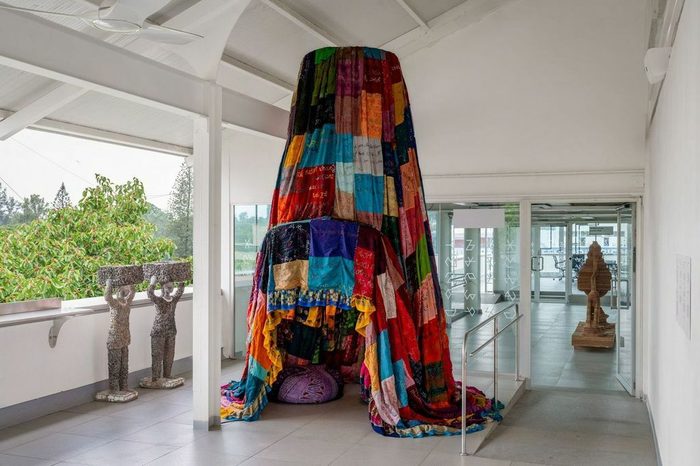
Some men used Antony’s incongruity to dissuade their wives from going to Namma Katte, claiming that people like Antony would inevitably leave, and they are the ones who would be there when she did.
But Antony persisted. She continued to show up, day after day. Sometime around the third month, the shy trickle of women grew to a curious stream. Some were lured by Antony’s offer to teach them embroidery. After learning the craft, one woman, who was illiterate, marveled at the cloth on which she had marked her existence: “I have never signed my name, but now I am stitching it.”
Once they knew how to embroider, Antony invited each woman to stitch a personal story onto salvaged saree scraps. The women hesitated … could they really talk about their lives? And if they did, who would care? But slowly, as they grew comfortable with each other, small talk about their children gave way to tales of their lives: “She didn’t actually trip and fall down the stairs; her sister-in-law pushed her.”
“Can you believe her husband just stood there and let her burn to death?”
One day, a woman said she’d heard her neighbor drunkenly beating his wife. Such stories were not uncommon, but then another added: “That happens to me too.” Antony felt time stop. All of the stories so far had been of neighbors and friends — of misfortune somewhere else. No one had yet shared her own story.
But courage begets courage, and once the floodgate opened, more tales of intimate heartache flowed: “I hardly slept during those days; he drank a lot.” “I woke up after the acid attack to see that I have lost one eye.”
Thirty stories became 100, then 300. Six months after Namma Katte’s opening, women were marching in to declare, “I want to stitch my story, give me a cloth!” A year later, the women of Lingarajapuram had stitched 547 stories, then joined them to create “Nanna Langa” (“My Skirt”). When hung, the piece is about 20 feet tall and looks like a protective cloak, large enough for all of them.
Antony was shocked by the stories shared in those afternoons of stitching and chai. But even more stunning was the women’s nonchalance as they recounted tragedy after tragedy. But was it actually nonchalance, or was it resignation, or stifled grief? Was their indifference feigned, a defense against pain? Antony was haunted by the harrowing deaths recounted by this whisper network, and vowed to commemorate these lost sisters’ lives.
To do so, Antony turned to the oppari, a traditional mourning song performed at Tamil funerals. An increasingly rare art form, Antony scoured Bengaluru for singers. She eventually found six grandmothers, all of whom were surprised to hear from her because “no one calls us anymore.”
The grandmothers first looked at Antony askance. An art project? What did they know about art? They knew only funerals, where their performances praised the recently deceased and lamented their passing. While their lyrics were effusive, they were also generic; the singers generally knew little about those they were hired to mourn.
Antony, however, had a different kind of oppari in mind. Once she gathered the singers, she told the stories of 10 women from the Namma Katte community who had been killed. As the grandmothers listened, their wariness dissolved: Antony was no longer a strange artist asking them to participate in strange art; she was a sister who knew the pain of womanhood. For in these stories, they heard the truth of their own lives.
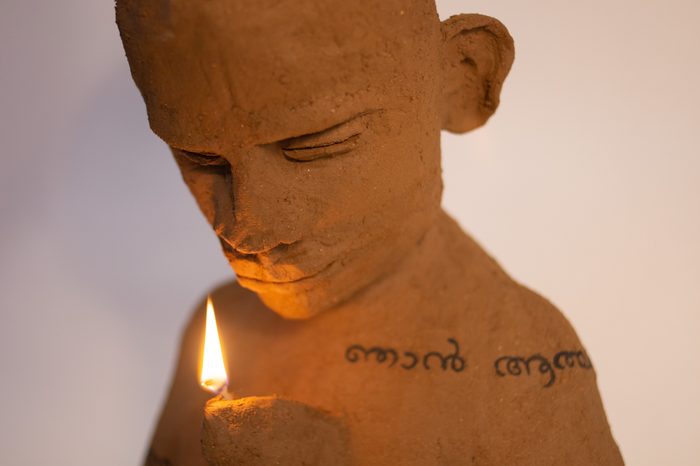
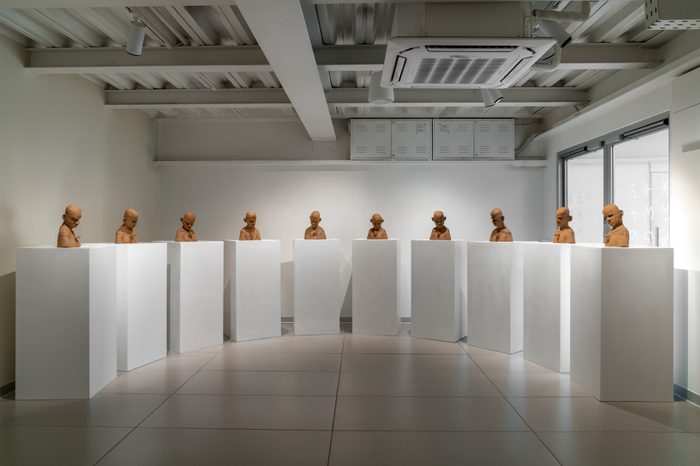
Once Antony finished, they joined hands and began singing: “We are all old but you are too young to die, my dear. Why did your mother-in-law have to torture you so much? Why has she hit you like this? Does God even have eyes or does he not?”
“You brother’s wife, what a heartless traitor she has to be to push you off a building when you were pregnant. Oh my dear, what pain that unborn child must have suffered, oh God, dear God! It doesn’t matter how many temples I go to, this pain will always leave me unfulfilled, within me.”
The grandmothers soon shifted from singing about the tragedies they heard to freestyling about the tragedies they lived. One’s daughter had also suffered a dowry death — her mother-in-law had set her on fire— and she now wailed for her child. Arm-in-arm, these women were no longer mourning strangers. They were mourning their neighbors, their friends, their daughters, their granddaughters, and all of the women they had not met but whose pain they knew.
“I came to this town in ’62, when I was a small girl. I wasn’t even a big girl when I got married. My mother-in-law would hit and kick me, not even feed me. I would eat raw onions and water for my hunger.”
“I am the sinner that bore children for him. He said he will cry for me and stay with me, but even he left me. My troubles do not seem to end. Who will I go and tell my troubles to?”
“In the land I was born, I don’t have anything to call mine. I have no joy to call mine.”
The grandmothers sang for 27 minutes without pause, then looked at each other’s tear-drenched faces, startled. They were used to performing grief, but they rarely dared to let themselves feel it.
“We should do this more often,” one said. Another nodded, then another. Yes we should, nodded the dadis who had seen it all.
What happens once we acknowledge the pain permeating our collective? Once we let ourselves really cry, can we ever stop? The grandmothers had once feared their grief — but what were its possibilities?
MOURNING AS A SITE OF SOLIDARITY
In 2020, a 19-year-old Dalit woman was gang-raped by four high-caste men in Uttar Pradesh. She died two weeks later. Her remains were hastily cremated by the police without the consent of her family, who were put under house arrest and barred from organizing a funeral.
An obvious reason for a hurried cremation might be to destroy evidence, but cultural theorist Brahma Prakash suggests another logic: The Indian government feared what might emerge from collective mourning. The woman’s death had already created an uproar among Dalit communities, and authorities feared a funeral would turn into a political procession.
“What is it that we are mourning?” Prakash asks in Body on the Barricades: Life, Art and Resistance in Contemporary India. “Are we mourning the loss of an individual life or are we mourning our collective failure? Are we trying to see death in isolation and fatalism, or are we also mourning our democracy and justice systems?”
Prakash observes that grief is felt and processed individually, but many cultures have rituals — through dress, prayer, food, music — to channel individual grief into collective expressions. Because mourning can also carry a political function: to bear witness and, when the cause of that which we mourn is unjust, to organize against future such injustices.
Authoritarian governments understand the power of mourning to radicalize and mobilize. Prakash believes clampdowns on mourning processions across India, in the Uttar Pradesh case and beyond, stem from this recognition. “[Mourning processions] become a last time where solidarity can be forged [in response to an injustice] and it can get out of hand at any time,” he observes. “This has happened several times in Kashmir, and in other parts of India where people come together in social mourning rituals. And that is what authorities are scared of.”
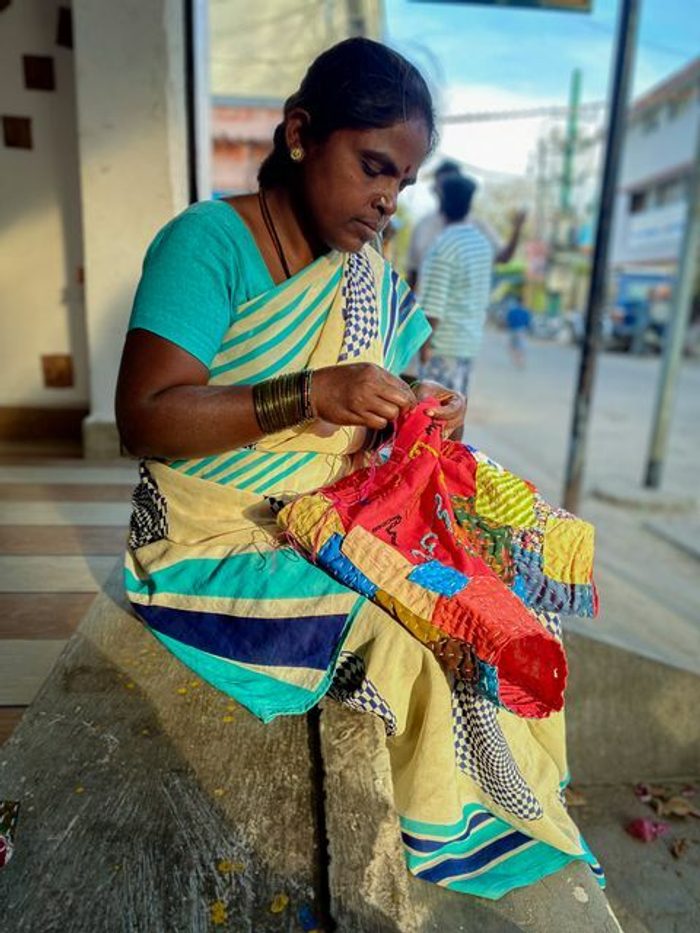
In 2016, prominent Kashmiri liberation fighter Burhan Wani was killed by Indian occupation forces. To the government, he was a terrorist; to many Kashmiri youth, he was hope. About a week after his funeral, authorities suspended mobile data services, closed schools and blocked roads to his village. Yet thousands of people were determined to pay their respects and endured beatings from security forces to do so. After the funeral, many young people joined the separatist group Hizbul Mujahideen, in which Wani had been a commander.
The practice of collective mourning, Prakash observes, helped reignite the Kashmiri freedom movement.
What other freedom struggles might mourning fuel?
It was at Antony’s exhibition Mindscapes: In the company of others, at Bengaluru’s Museum of Art and Photography, that I first encountered the grandmothers’ oppari. As I approached 10 clay busts, each on an individual plinth, I was drawn to their lowered gazes — a mix of sorrow, regret, resignation. I put on the headphones to listen to “Us,” a recording of the oppari’s wails; I gasped in recognition. I did not understand Tamil, yet I knew of what these women sang: This was a song chiseled out of grief generations long and galaxies deep. It is the same timbre of sorrow my mother knows, as does her mother, as does her mother’s mother. As their daughter, it is the sorrow I carry in my bones. I had long known its weight; now I knew its sound.
The faces of the women of Lingarajapuram flashed across my mind. Sisters who had paid the ultimate price for being born a woman in a world that hates women. The grandmothers’ song was the cry of tormented helplessness.
It was a commitment to steadfast witnessing through the agony.
SLOWLY SLOWLY, SMALL SMALL CHANGES
In February, Namma Katte celebrated its second anniversary. It recently hosted a skills-sharing workshop where women taught each other how to tailor. There is now chatter about organizing a community nursery. For local women, having a trusted place to put their children would mean they could work, which would mean more autonomy, more freedom.
Watching more and more women take ownership over Namma Katte, and using it to root their rest and organizing, has been illuminating for Antony. “I see these small, small changes happening,” she says. Men used to get drunk and break bottles outside; today, the corner is free of glass shards. In the early days of Namma Katte, men used to scowl as they walked by; today, many keep a respectful distance and greet the women. Before Namma Katte, interaction between most women in the neighborhood was limited to exchanging pleasantries at the market; today, the women of Namma Katte laugh together and watch one another’s children; they have become beautifully entangled.
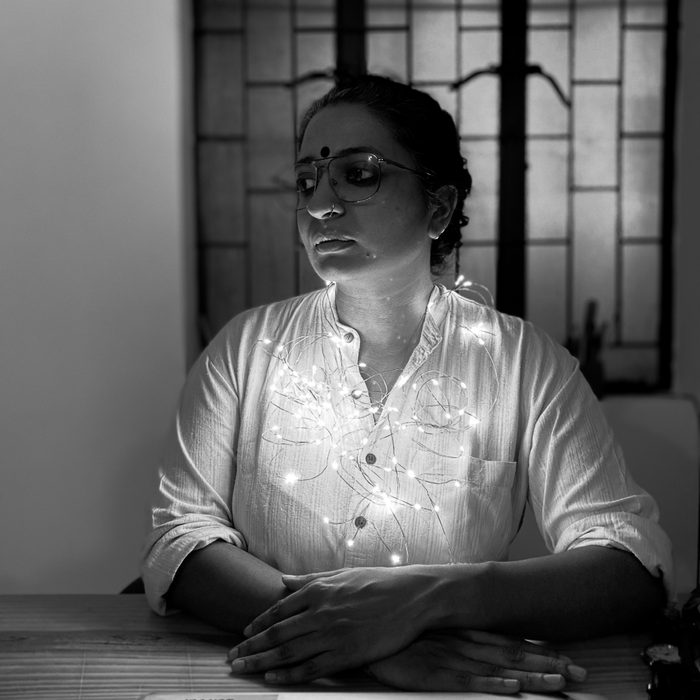
One regular, Glory, who works long hours as a maid, often visits after work to collect herself before returning home. She savors her Namma Katte drop-ins: “When I come here, my mind is free.”
Namma Katte shows the revolutionary potential of women resting, gathering and laughing together. And it is not just women who have succumbed to its energy. Recently, some young men from the neighborhood formed a group called the Namma Katte Squad. Many used to ban their sisters from leaving home; now, they are permitted to go to Namma Katte.
Antony remains frustrated that the women need to ask permission, but she knows directly challenging the boys would be ineffective. “Patriarchy is so ingrained, I cannot come in with a poster that says ‘smash patriarchy,’ I cannot [dismantle it] overnight,” she says. “It’s a slow unravel. It takes a lot of time. But slowly, slowly, slowly, we can break things one by one.”
For the recent Ganesha Festival, an annual celebration of the elephant-headed deity, the Namma Katte Squad organized a celebration outside the space. For Hindus, Lord Ganesha is the god of wisdom and prosperity, the remover of obstacles. The significance of the men choosing to observe this festival at the women’s center was not lost on Antony. They are proud that the women have a community space and want to show support.
A year after he came to burn the woman’s stitching, the political official returned. Antony saw him walking up to the center and braced herself, but as he got closer, she noticed something strange: He was smiling.
“You are doing such great work,” he cooed. “I’m seeing such important changes from what you are doing!” Antony, he had come to understand, was a crowd-puller among women. Would she like to stand for his campaign in the upcoming election?
She stifled a chuckle. Perhaps the change Namma Katte was seeding was not so small, small after all.
Panthea Lee (李佩珊) is a Taipei-based writer, activist and trans-disciplinary facilitator. Rooted in commitments to deimperialization and collective healing, and drawing on her work in over 30 countries, her practice explores ways to weave the spiritual and political in realizing structural justice. She is writing a book on healing, imagination and structural justice.

